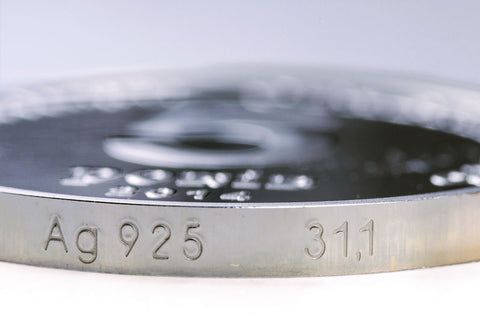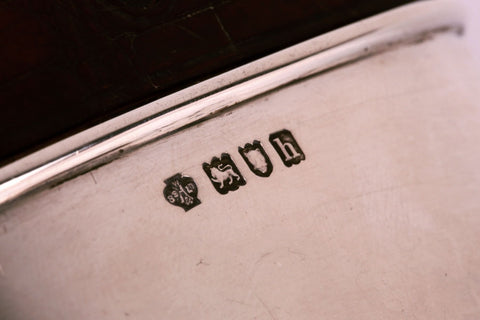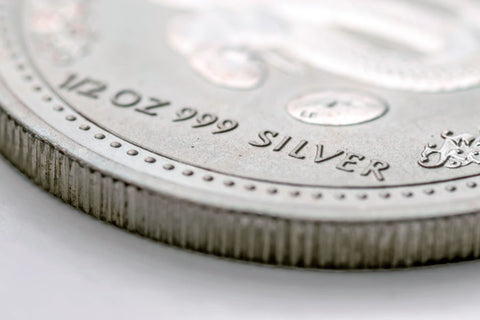by Jesús Zabala - 6 min read
When Did Silver Hallmarks Start?
Hallmarks on jewelry are essential identifiers of purity and serve as a form of consumer protection. After all, when you purchase a silver piece, you want to ensure the metal’s purity. But when did silver hallmarks start?
Join us as we explore the origins of hallmarking and its adoption across various countries.

Source: shutterstock.com / Photo Contributor: VladKK
Origins of Silver Hallmarks
Is all old silver hallmarked? The earliest discovered silver objects with marks on them date to around 400 AD. This shows that the concept of hallmarking dates back to the Byzantine period. In Anatolia, archaeologists have found historic slag heaps used for the cupellation process.
The process involves heating ores to extremely high temperatures to separate precious metals like gold, silver, palladium, and platinum. The ores are estimated to be about 6,000 years old.
However, official marking systems date to 1238 Britain, so not all old silver is hallmarked. Official hallmarking first began in 1260 in France for King Louis IX.
The official hallmarking systems were intended and still serve as indicators and proof of the purity of the silver.
The early history of silver craftsmanship and trade
Silver was a common currency in the ancient Greek, Egyptian, and Roman civilizations, among others.
Today, all silver objects meant for commercial sale are stamped with one or more silver hallmarks, which vary depending on the country of origin.
Some countries assign the control of testing silver objects and their purity marking to a national assayer office. The process of hallmarking involves using a hammer and punch to apply it to a silver object.
Marking systems to verify silver authenticity
In 1180, Henry II established the “Goldsmiths Guild” in London and allowed it to use the Leopard's Head hallmark. He did this to ensure the purity of the gold and silver in the royal treasury.
As we briefly mentioned, the earliest attempt to regulate the standard of silver dates to 1238 in the UK. The attempt involved King Henry III passing an order that commanded the mayor and aldermen of the City of London to appoint six trusted goldsmiths to the city.
These goldsmiths were to supervise the fineness of silver and gold according to stipulated standards. However, with only six goldsmiths having a monopoly over all the silver and gold led to many instances of fraud.
In 1300, Edward I made another attempt to stop goldsmiths from committing fraud by creating a statute. According to the statute, the "Guardians of the craft" were tasked with applying the leopard's head mark and doing assay work from each shop.
The required standards for silver were sterling standard (92.5% pure silver) and "touch of Paris" gold (19.2 carats). Goldsmiths outside of London were expected to adhere to the same rules.

Source: shutterstock.com / Photo Contributor: Mr SW Photo
Early Silver Hallmarking Practices by Country
The establishment of the Goldsmiths' Company
An Edward III decree established the maker's mark, which was now mandated in addition to the leopard's head and designated the goldsmith in charge of creating a piece of plate.
The Goldsmiths’ Company, first established as a medieval guild for the goldsmith trade, in 1327 received a Royal Charter. With this, Edward III formalized the Goldsmiths Company and introduced a maker’s mark and a date letter alongside the Leopard’s Head.
The Goldsmiths' Company was explicitly made accountable for and subject to fines for his wrongdoings, and the gold standard dropped to eighteen carats.
A new mark featuring the leopard's head with a crown was introduced in order to distinguish between the old and new plates as a result of this alteration.
The assay office and the introduction of hallmarking
With the Leopard's Head, maker's mark, and date letter in place, most hallmarking components were introduced at this point. So, with most components in place and the formalization of the Guild, the organization had a permanent assay office.
An assay office mark was the town mark of its location. While there is no record of the exact introduction of town marks, a 1423 law mentions seven assay offices besides the one in London.
This tells us that the use of town marks had already started by 1423. So, the Leopard’s Head indicated two things: the purity of silver and that it had been assayed in London.
Today, the remaining open assay offices in the UK are in London, Birmingham, Sheffield, and Edinburgh.
Germany and the role of guilds
Unlike the UK, which had several towns with dedicated assay offices, in Germany, until 1884, each city had its own town mark. The system of hallmarking in Germany was regulated by its guilds.
The guilds indicated the purity of gold and silver in “Löthig,” with 16 löthig indicating pure silver or gold. While all towns had strictly regulated markings, the town of Hanau had a unique way of marking silver.
The silversmiths in Hanau could stamp whatever marks they chose on their products, as the trade was not strictly regulated like in every other city.
Many objects originating from 19th-century Hanau have fantasy marks stamped on them that mimic antique hallmarks from other countries.
France and the establishment of the hallmarking system
Hallmarking first began with the Goldsmiths’ Statute announced under Etienne Boileau, Provost of Paris, for King Louis IX. As the French hallmarking system dates back to the 13th century, it is one of the most complex due to the many marks it contains.
However, the marking system for jewelry is simpler than for large silverware. It comprises a hallmark indicating the precious metals and a maker’s mark. For silver, the marks are a boar’s head or crab stamped on pieces with a minimum fineness of 800/1000.
Since 1838, objects made with pure silver have an assay mark of the head of the goddess Minerva. In France, there are two standards for identifying silver purity. Silver with 95% purity is referred to as the 1st Standard, while 80% silver is the 2nd standard.
Depending on the purity, either 1 or 2 is stamped with the head of Minerva. In contrast, French silver manufactured for export is stamped with an assay mark shaped like the head of Mercury along with a fineness number.
Asian countries and their unique hallmarking practices
Singapore and Japan are the only two Asian countries that have established voluntary hallmarking systems and official national standards for precious metals.
In Japan, the independent administrative institution, the Japan Mint, has assayed and hallmarked silver objects since 1929. The hallmarks bear the figure of the national flag of Japan.
On the other hand, in Singapore, the SAO (Singapore Assay Office) is the independent institution that tests and hallmarks precious metals. The SAO’s marking system consists of the SAO symbol of a lion’s head, the fineness standard mark, and the jeweler’s mark.
United States and the rise of assay offices
The hallmarking of precious metals in the early United States was only maintained in the city of Baltimore. Although no national assaying system was adopted, Baltimore maintained its own assay office between 1814 and 1830.
In 1868, the U.S. adopted sterling silver as a standard for purity. U.S. manufacturers did not apply assay marks, but they did stamp maker’s marks.
Today, in the U.S., according to law, quality-marked silver must be stamped with the name coin silver or a U.S.-registered trademark. “Coin silver” is used for compounds that contain 90% pure silver.

Source: shutterstock.com / Photo Contributor: VladKK
Conclusion
When did silver hallmarks start? Hallmarking officially began in 1260 in France for King Louis IX, although Henry III made an even earlier attempt in 1238 to regulate silver standards.
Ever since, hallmarking has evolved and been standardized based on separate countries, with each adopting its own marking systems.
-
DESIGNED & HANDMADE IN BALI
-
FREE RESIZING FOR EVERY PIECE
-
FREE SHIPPING ON $150+ ORDERS
-
100% SAFE & SECURE CHECKOUT






















































